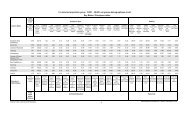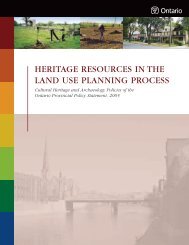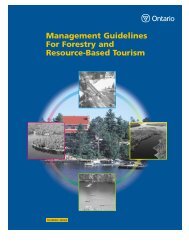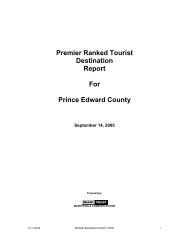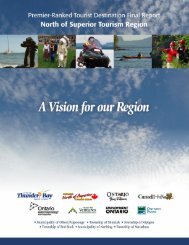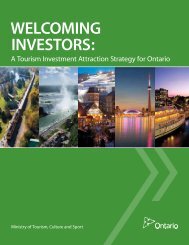Factors Influencing Visitor's Choices of Urban Destinations in North ...
Factors Influencing Visitor's Choices of Urban Destinations in North ...
Factors Influencing Visitor's Choices of Urban Destinations in North ...
Create successful ePaper yourself
Turn your PDF publications into a flip-book with our unique Google optimized e-Paper software.
time from major orig<strong>in</strong> markets), competitive microenvironment, global macroenvironment, security and safety, and price competitiveness.6. Demand Conditions. This paper emphasizes the importance <strong>of</strong> demand conditions.The dest<strong>in</strong>ation may be competitive to one group <strong>of</strong> tourists, but not to another. Theauthors suggest that it is domestic tourism that triggers the nature and structure <strong>of</strong> anation’s tourism <strong>in</strong>dustry. Once domestic demand is established, foreign demandstarts to develop. In addition, the paper provides some discussion as to the differencebetween pull and push factors that motivate tourists to travel. “Pull” factors can beregarded as dest<strong>in</strong>ation attributes that fulfill visitor travel motives. “Push” factors areforces that arise from <strong>in</strong>dividuals and from <strong>in</strong>dividuals’ social context. “Push” factorsare real motives for people to determ<strong>in</strong>e a dest<strong>in</strong>ation’s competitiveness and to maketheir decision to travel. Demand conditions are a reflection <strong>of</strong> push factors. These<strong>in</strong>clude tourist preferences, <strong>in</strong>ternational awareness <strong>of</strong> dest<strong>in</strong>ation, overall dest<strong>in</strong>ationimage and <strong>in</strong>ternational awareness <strong>of</strong> the dest<strong>in</strong>ation’s specific product <strong>of</strong>fer<strong>in</strong>gs.7. Objective Performance Indicators <strong>of</strong> Dest<strong>in</strong>ation Competitiveness. The purpose <strong>of</strong>these <strong>in</strong>dicators is to measure the dest<strong>in</strong>ation competitiveness. First <strong>of</strong> all,performance can be measured statistically by us<strong>in</strong>g visitor statistics (number <strong>of</strong>visitors and their expenditures). Secondly, contribution <strong>of</strong> domestic and foreigntourism to an economy can be estimated by look<strong>in</strong>g at the contribution <strong>of</strong> tourism tovalue added, employment, and the productivity <strong>of</strong> tourism <strong>in</strong>dustry sectors. Thirdly, itis important to know the amount <strong>of</strong> <strong>in</strong>vestment <strong>in</strong> the tourism sector; also pricecompetitiveness <strong>in</strong>dexes, the extent <strong>of</strong> government support, and f<strong>in</strong>ancial <strong>in</strong>centivesfor tourism.8. Indicators <strong>of</strong> Economic Prosperity are aggregate level <strong>of</strong> employment, rate <strong>of</strong>economic growth, and per capita <strong>in</strong>come.Relevance to Our ResearchThis research attempts a very broad collection <strong>of</strong> factors that affect the relativecompetitiveness <strong>of</strong> dest<strong>in</strong>ations. They acknowledge the complexity <strong>of</strong> the dynamics <strong>of</strong>tourism attraction and attempt to provide a guide to beg<strong>in</strong> to measure this process.Although this complexity goes beyond the scope <strong>of</strong> our project, there are severalelements <strong>of</strong> these models that will help guide our classification <strong>of</strong> attractions.Dwyer and Kim’s latest model allows for the <strong>in</strong>teraction <strong>of</strong> different components, andGlobal Insight believes some <strong>in</strong>dication <strong>of</strong> the complementarity <strong>of</strong> city attractions will beimportant to our classification. Additionally, Dwyer and Kim <strong>in</strong>dicate the importance <strong>of</strong>shopp<strong>in</strong>g as an important part <strong>of</strong> tourist attractors. Their emphasis on <strong>in</strong>frastructureattests to the importance <strong>of</strong> the ease with which tourists are able to access the attractionsthey want to visit.<strong>Urban</strong> Tourism Market<strong>in</strong>g Literature<strong>Urban</strong> Tourism Market<strong>in</strong>g Literature provides a discussion <strong>of</strong> market<strong>in</strong>g strategiesundertaken by urban authorities and tourism marketers. Essentially, the idea beh<strong>in</strong>dmarket<strong>in</strong>g is to make a tourist model—which was discussed <strong>in</strong> the previous section—attract more tourists and generate more revenue to the local economy. “A dest<strong>in</strong>ation thathas a tourism vision, shares this vision among all stakeholders, understands both its48


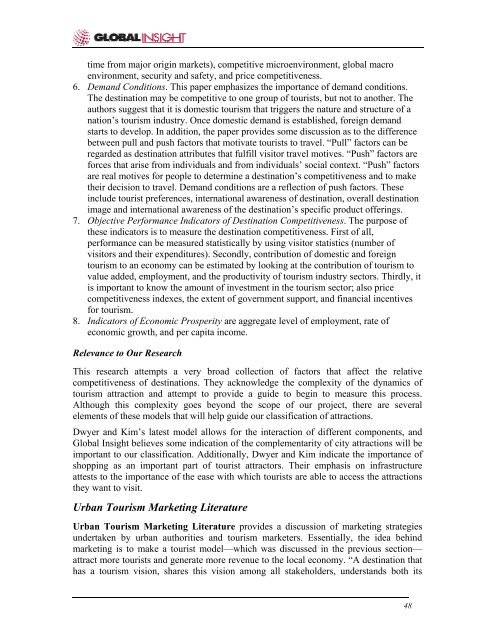
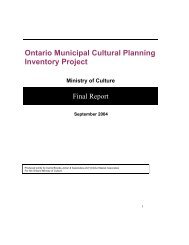
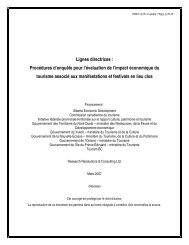
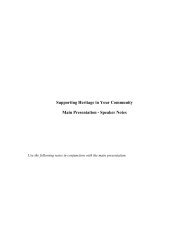
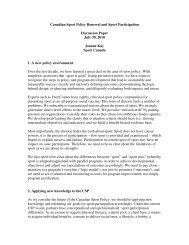
![THIS AGREEMENT made this [date], between [name of owner] (the ...](https://img.yumpu.com/49827605/1/158x260/this-agreement-made-this-date-between-name-of-owner-the-.jpg?quality=85)

